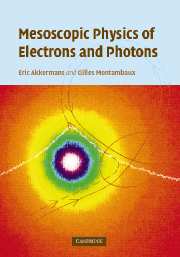Book contents
- Frontmatter
- Contents
- Preface
- How to use this book
- 1 Introduction: mesoscopic physics
- 2 Wave equations in random media
- 3 Perturbation theory
- 4 Probability of quantum diffusion
- 5 Properties of the diffusion equation
- 6 Dephasing
- 7 Electronic transport
- 8 Coherent backscattering of light
- 9 Diffusing wave spectroscopy
- 10 Spectral properties of disordered metals
- 11 Universal conductance fluctuations
- 12 Correlations of speckle patterns
- 13 Interactions and diffusion
- 14 Orbital magnetism and persistent currents
- 15 Formulary
- References
- Index
5 - Properties of the diffusion equation
Published online by Cambridge University Press: 06 January 2010
- Frontmatter
- Contents
- Preface
- How to use this book
- 1 Introduction: mesoscopic physics
- 2 Wave equations in random media
- 3 Perturbation theory
- 4 Probability of quantum diffusion
- 5 Properties of the diffusion equation
- 6 Dephasing
- 7 Electronic transport
- 8 Coherent backscattering of light
- 9 Diffusing wave spectroscopy
- 10 Spectral properties of disordered metals
- 11 Universal conductance fluctuations
- 12 Correlations of speckle patterns
- 13 Interactions and diffusion
- 14 Orbital magnetism and persistent currents
- 15 Formulary
- References
- Index
Summary
Introduction
In Chapter 4, we established general expressions for the probability of quantum diffusion Pd (r, r′, ω) and for the structure factor Γω(r, r). With the aid of these quantities, which are solutions of the integral equations (4.24) and (4.25), we can describe all the physical phenomena studied in this book. It is therefore useful to present these solutions for commonly encountered geometries. Moreover, we have shown that for an infinite medium, in the regime of slow variations, Pd and Γω are solutions of a diffusion equation. In this chapter, we shall study the solutions of this equation for certain geometries. The validity of the diffusion equation will be discussed for the cases of infinite and semi-infinite media in Appendices A5.1 and A5.3.
We shall take particular interest in the Laplace transform Pγ (r, r′) of the probability P(r, r′, t). This measures the sum of the contributions to the probability from multiple scattering trajectories between r and r′ for times less than 1/γ. From this quantity we shall define a characteristic time, the recurrence time, which describes the total time spent around an arbitrary point in the medium. It depends on the space dimensionality and on the geometry of the system.
For a finite system, typically a cube of side L, there is a natural characteristic time scale τD defined by L2 = DτD. It separates the short time regime, where the role of boundary conditions may be neglected, from the long time regime where these conditions become essential. The inverse of this time defines the so-called Thouless frequency 1/τD or the Thouless energy Ec = ħ/τD.
- Type
- Chapter
- Information
- Mesoscopic Physics of Electrons and Photons , pp. 148 - 194Publisher: Cambridge University PressPrint publication year: 2007

